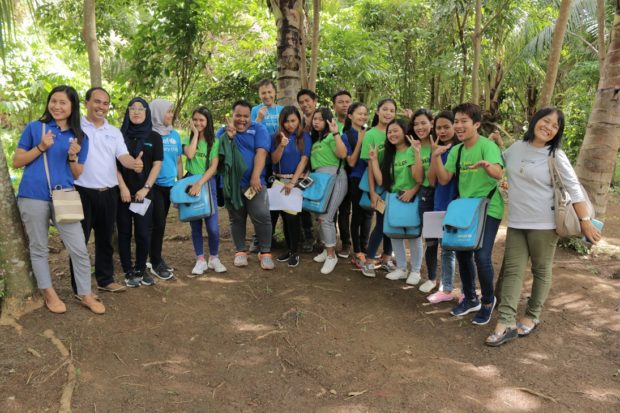
Youth volunteers, community organizers and field assistants are joined by UNICEF and CFSI staff in a light moment at Kidapawan City. ©UNICEF Philippines/ 2020/Francia
MANILA Rhea, 16 and Hamdia, 19, had the same reaction when the magnitude 6 Mindanao earthquakes occurred in October 2019—they both froze in place.
In North Cotabato, October 16, 29 and 31, 2019 are dates routinely mentioned by residents as they recount their experience of each violent shaking. In the province, around 175,000 children and youth were affected by the strong earthquakes.
Indigenous children experience nature’s fury
Rhea Catubay belongs to the Manobo indigenous tribe.
“We Manobos worship the trees, rocks and nature. Some elders say that Manobos have sinned because we were among those most affected by the earthquake. That is why we gather together and pray,” Rhea says.
Rhea, a Grade 10 student in Kidapawan City National High School, has been volunteering in various youth programs and found a rewarding experience giving psychological first aid to children. She attended a youth volunteer training supported by UNICEF and Community and Family Services International (CFSI). The youth volunteers conduct psychosocial support activities in evacuation centers to help children overcome their fears and ensure that they have a safe space to play and just be children.
To date, around 250 youth volunteers from the affected population have been trained to help children return to normalcy. They undergo a three-day training where they learn about profound stress, emotional dialogue, management of child friendly spaces and key child protection issues such as prevention of sexual exploitation. They receive coaching and mentoring support so that they can hone their skills and continue working with the children in their villages.
“It’s important to provide opportunities for meaningful participation and engagement for adolescent and youth from the affected communities because it will give them a sense of purpose. Being empowered allows them to cope positively and overcome the daily challenges they face,” UNICEF Mindanao Field Office Child Protection Specialist Farid Dastgeer says.
“When I play with the children, I think of my baby brother John Kiefer who is nine months old. The feeling of happiness I get when I play with my baby brother is the same happiness I feel when I see smiles from children we help,” Rhea’s face lights up as a little girl asks to play with her.
No home to return to
Hamdia Palawan, 19, lives in Barangay Buhay, one of the worst-affected villages in Makilala, North Cotabato. She showed visible signs of stress when they first relocated to Kidapawan City, an hour away from their village.
“I was so afraid when the earthquake happened that I just froze, then fainted. When we moved to the evacuation center and another earthquake happened, our temporary shelter collapsed on us. I want to help my community, that’s why I joined to become a youth volunteer,” she says.
Hamdia, her mother Milayna and brother Hanan are actively helping their community in the MIST Evacuation Center. Hamdia and Hanan are trained as youth volunteers while mother Milayna is a day care worker. ©UNICEF Philippines/ 2020/Francia
Hamdia is joined by her brother Hanan, 17, in the psychological first aid training. Soon, they will be the ones conducting psychosocial support activities for their ten other younger brothers and sisters, as well as their neighbors from Barangay Buhay.
“We are not ready to go back home. There is nothing to go back to since our house was completely destroyed. For now, I want to learn how to help the children who were affected by the earthquake. I want to share what I learned with my community,” she says.
UNICEF is helping children affected by the earthquake by making sure they enjoy their rights to education, access to safe drinking water and sanitation, as well as protection from violence, exploitation and abuse. UNICEF and partners are providing them with supplies such as toys, water and hygiene kits, and school-in-a-box kits; training community workers and teachers in psychological first aid; setting up temporary learning and child-friendly spaces; and referring vulnerable children, including those with profound stress, to the proper authorities for intervention.